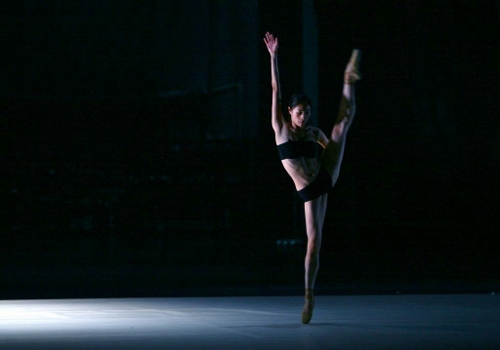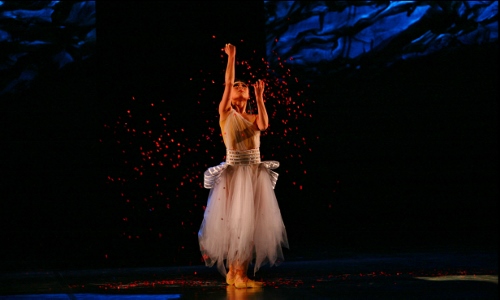|
 |
|
|
 |
 |
As the curtain rose this past Friday at Playhouse Square’s Ohio Theatre, it revealed a sculptural piece suspended low over the stage looking like a deconstructed top spinning round. That image was soon replaced by dancers clad in black shorts and tops who, as the sculpture was raised slowly into the rafters, filtered onto the bare stage and began a flurry of stylized contemporary dance choreography. It was the first glimpse of Beijing Dance Theater making their Cleveland debut as the first Chinese troupe presented by DANCECleveland (in collaboration with Tri-C Performing Arts and Cleveland Public Library) in its 63-year history. Founded in 2008 by award-winning choreographer/artistic director WANG Yuanyuan, Beijing Dance Theater (BDT) is one of a scant few contemporary dance companies in China. The dozen-plus member troupe showed its stylistic range in a trio of varied repertory works by WANG presented February 2 beginning with “Farewell, Shadows,” an excerpt from her 2014 work Wild Grass. Set to music by Frenchman Kangding Ray, the work resembled a William Forsythe work such as “In the Middle, Somewhat Elevated” or that of choreographer Ji?™i Kylián (whom WANG says she admires) in its approach. BDT’s dancers marched emotionless on and off the stage taking turns occupying the audience’s gaze in various dancer configurations and performing sleek, sharp-angled choreography that twisted, turned and saw taught legs rocketing skyward. Inspired by Lu Xin’s 100-year-old poem about control, WANG created the work as an abstract reflection on China’s current and past repressive social and political climates — the 20-minute piece was ripe with images of being controlled and controlling others in the dancers’ partnered movements. A solid opener overall, the only knocks on its performance were a lack crispness at times in the dancing and some of the partnering appeared a bit shaky. A standout however, in the work and throughout the program, was dancer HU Jing whose fluid movements and captivating stage presence commanded attention. Next, tapping into her traditional Chinese folk dance background learned at the Beijing Dance Academy, WANG’s “Crossing” (2008) mixed traditional Chinese dance with that of sped up Tai Chi movement. Danced to an atmospheric score by WU Jun and LIU Bo, the 17-minute work began with a solo dancer rolling out a streamer along a corridor of light at the rear of the otherwise darkened stage. Soon other dancers joined in rolling out more streamers across the lengths of the floor to frame and bisect the stage space. The quiet work showcased a swirling, elegant movement language that fit well on the cast of six men and four women both technically and seemingly spiritually. Costumed in loose-fitting grey pants and teal shirts, the dancers, in various groupings and configurations, appeared to swirl and melt into WANG’s choreography creating a mesmerizing visual display. While “Crossing” laid out a clear path of intent from start to finish, the program’s final work, a 37-minute excerpt from WANG’s Hamlet, felt disjointed. Joining Shakespeare’s tragic tale near its end and lacking the ballet’s dramatic sets because they wouldn’t fit the Ohio Theatre’s stage space, the surreal Hamlet excerpt lacked context on its own. Further hindered by WANG’s abstract approach to portraying the Prince’s inner struggle with good and evil over avenging his father’s death, the work’s beauty took a while to come into focus. Danced to music by German composer Dirk Haubrich, at the outset the excerpt appeared more like a scene from a dark version of the ballet Coppélia than Hamlet. Dancer ZHENG Jie as Prince Hamlet flitted about the stage moving the limbs of and repositioning the bodies of over half a dozen dancers representing characters in story that were symbolically or metaphorically made doll-like. Perhaps alluding to his character on the verge of madness, ZHENG imbued the Prince with an almost over-the-top theatricality in the repetitive scene which lasted long after its symbolic point had been made. Salvation for the excerpt followed however in the form of dancer ZHAO Wuyue as the radiant ghost of Hamlet’s doomed love interest Ophelia. In a white dress and appearing before Prince Hamlet, ZHAO, while slowly and gracefully dancing about the stage, dropped a seemingly endless supply of confetti representative of minute flower petals from her hands as she danced. The scene had a Giselle-like quality to it with a frightened and perhaps guilt-ridden Prince Hamlet haunted by her presence. ZHAO’s performance was spellbindingly beautiful and capped off a mostly successful debut for Beijing Dance Theater that brought the audience to its feet in appreciation.
 From “Farewell, Shadows”. Photo © & courtesy of Han Jiang |
|
 From “Farewell, Shadows”. Photo © & courtesy of Han Jiang |
|
 ZHAO Wuyue as Ophelia in WANG Yuanyuan's "Hamlet". Photo © & courtesy of Han Jiang |
|
|
|




